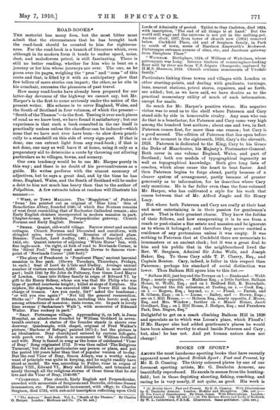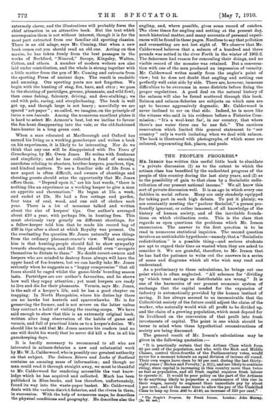BOOKS ON SPORT.*
AMONG the most handsome sporting books that have recently appeared must be placed British Sport : Past and Present, by Mr. E. D. Cuming. The thirty coloured plates by one of our foremost sporting artists, Mr. G. Denholm Armour, are beautifully reproduced. He excels in scenes from the hunting. field ; but in those depicting shooting, fishing, coaching, and racing he is very nearly, if not quite, as good. His work is • (1) British Sport : Past and Present. By E. D. Claming. With Illustrations by G. Denholm Armour. London : Hodder and Stanghton. [GM. net.}— (2) Ton Years of Ganisksviag' . By Owen Jones. With Dlustrations, London Edward Arnold: [10s. 6d. net.]—(8) The Salmon Biters and"Loolis of Scotland. By W. L. Calderwood..F.B.B.M. Illustrated. Banmpubkhdiea qdle. sista extremely clever, and the illustrations will probably form the chief attraction in an attractive book. But the text which accompanies them is not without interest, though it is for the most part extracted from our familiar old sporting classics. There is an old adage, says Mr. Cuming, that when a new book comes out you should read an old one. Acting on this maxim, he has taken freely from the best passages in the works of Beckford, "Nimrod," Scrope, Kingsley, Walton, Cotton, and others. A number of modern writers are also laid under contribution, and the whole is strung together with a little matter from the pen of Mr. Cuming and extracts from the sporting Press of ancient days. The result is readable and amusing. Our sporting poets are not forgotten. We begin with the hunting of stag, fox, hare, and otter ; we pass to the shooting of partridges, grouse, pheasants, and wildfowl; then come fishing, falconry, driving, and deer-stalking ; we end with polo, racing, and steeplechasing. The book is well got up, and though large is not heavy ; mercifully we are spared " art-paper" ; so-called, we imagine, on the principle of luaus a non lucendo. Among the numerous excellent plates it is bard to select Mr. Armour's best, but we incline to favour the fox-hunt disappearing into the vale, or the old-fashioned hare-bunter in a long green coat.
When a man educated at Marlborough and Oxford has earned his living as a working gamekeeper and writes a book on his experiences, it is likely to be interesting. Nor do we think that any one will be disappointed with Ten Years of Gamekeeping, by Mr. Owen Jones. He writes with freshness and simplicity; and he has collected a fund of amusing anecdotes relating to shooters, brother-keepers, poachers, tips, and kindred matters. To see a familiar side of life from a new aspect is often difficult, and owners of shootings and shooting guests should seize the opportunity that Mr. Jones offers them. "Depend upon it," are his last words, "there is nothing like an experience as a working keeper to give a man an appetite and rheumatism." He began at 15s. a week, and ended at 228. He had a free cottage and garden, four tons of coal, wood, and one suit of clothes each year. There is a lot of nonsense talked and written about the size of keepers' tips. Our author's averaged about 210 a year, with perhaps 50s. in hunting fees. This must obviously vary greatly on different shootings, for a fellow-keeper told him that he made his record bag of 230 in tips after a shoot at which Royalty was present. On the everlasting fox question Mr. Jones naturally sees things from the ordinary pheasant-rearer's view. What surprises him is that hunting-people should fail to show sympathy towards shooting-men, and that they should even " arrogate themselves to dictate to them." No doubt covert-owners and keepers who are minded to destroy foxes always will have the upper hand of fox-hunters, but we can hardly take Mr. Jones seriously when he suggests as a " happy compromise " that all foxes should be caged whilst the game-birds' breeding season lasts. Partridges are our author's favourites, and he shows how well they repay attention ; yet most keepers are ready to live and die for their pheasants. Vermin, says Mr. Jones, is the salt of a keeper's life, and he has a good chapter on trapping. In North Hampshire, where his duties lay there are no hawks but kestrels and sparrowhawks. He is for preserving the former, and is not severe on the latter unless they contract a habit of visiting the rearing-coops. We have said enough to show that this is an extremely original book, written after long observation of the habits of game and vermin, and full of practical hints as to a keeper's duties. We should like to add that Mr. Jones assures his readers (and no one will doubt his word) that be never did kill a fox in all his gamekeeping days.
It is hardly necessary to recommend to all who are interested in salmon-fisheries a new and substantial work by Mr. W. L. Calderwood, who is possibly our greatest authority on that subject. The Salmon _Rivers and Lochs of Scotland contains an amazing mass of information; and though no man could read it through straight away, we must be thankful to Mr. Calderwood for rendering accessible the vast know- ledge which he has acquired and collected. Much has been published in Blue-books, and has therefore, unfortunately, found its way into the waste-paper basket. Mr. Oalderwood deals with the various district fisheries, and the rivers in them, in succession. With the help of numerous maps, he describes the physical conditions and geography. He describes also the angling, and, where possible, gives some record of catches. The close times for angling and netting at the present day, much historical matter, and many accounts of personal experi- ences will be found in these pages. Needless to say that pollution and overnetting are not lost sight of. We observe that Mr. Calderwood believes that a salmon of a hundred and three pounds was netted in the river Forth in the winter of 1901-2. The fishermen had reason for concealing their doings, and no visible record of the monster was retained. But a conversa- tion with one of the men produced an impression of veracity. Mr. Calderwood writes mostly from the angler's point of view; but he does not doubt that angling and netting can perfectly well exist side by side. There are, however, immense difficulties to be overcome in some districts before fixing the proper regulations. A good deal on the natural history of the salmon will also be found scattered through this book. Salmon and salmon-fisheries are subjects on which men are apt to become aggressively dogmatic. Mr. Calderwood is never inclined to err on that side. Indeed, be is more like the witness who said in his evidence before a Fisheries Com- mission : "It's a weel-kent fac', in oor country, that where there's nae water there can be nae fish." The cautious reservation which limited this general statement to "oor country " only is worth imitating when we deal with salmon. The book is illustrated with photographs, of which some are coloured, representing fish, places, and pools.











































 Previous page
Previous page